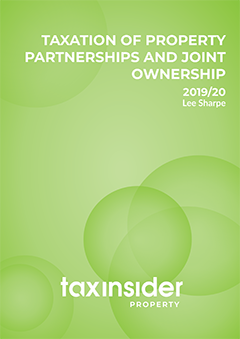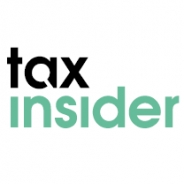
This article is an extract from our specialist tax report Taxation of Property Partnerships and Joint Ownership
The precise saving potentially to be made will depend on the particular circumstances, with due regard to adjustments for pension contributions, gift aid, and particular types of income and gains, but as a general rule, for 2019/20:
-
Where a 40% taxpayer is able to share his or her income with another who has unused 20% Basic Rate band, then the overall tax saving can be as high as £7,500 for each additional joint owner (Basic Rate Band of £37,500 @ (40% - 20%)).
-
Where a 40% taxpayer is able to share his or her income with another who has no other income at all, such that all of their tax-free Personal Allowance is also available, then the tax saving can be as high as £12,500per additional joint owner.
Other factors potentially to consider where prospective joint owners are close family, etc:
Benefits entitlement – a person may lose entitlement to state benefits if his or her income increases (although several income benefits are assessed by reference to overall household income anyway, so the first investor’s income may already be ‘counted’);
Student and Postgraduate Loan Repayments – a liability is triggered once income exceeds a certain threshold (£18,935for ‘Plan 1’ loans in 2019/20; £21,000 for Postgraduate loans and £25,725 for ‘Plan 2’ loans) so receipt of additional income can trigger a loan repayment, while a fall in assessable income may reduce exposure – note that the Postgraduate Loan repayment can be in addition to any amount due for Student Loans, bringing the aggregate repayment rate to as much as 15%;
Capital Gains Tax – access to the lower rate(s) of CGT of 10% (18% where disposing of an interest in residential property) depends on the extent to which the taxpayer has unused Income Tax Basic Rate Band (TCGA 1992 s 4 et seq.);
Transferrable Marriage Allowance – the flexibility to transfer ‘unused’ Personal Allowance to one’s spouse or civil partner may be forfeit if either the ‘donor’ or ‘donee’s’ income is too high. But, in most circumstances, it will be at least as efficient for each taxpayer to keep and utilise their own Personal Allowance in full (ITA 20017 s 55B, 55C);
Access to the full £1,000 New ‘Savings Allowance’ – the effective 0% rate band attaching to any savings income above the Starting Rate for Savings falls from £1,000 to £500 when the taxpayer has ‘higher rate income’ (ITA 2007 s 12A, 12B);
High Income Child Benefit Charge/Clawback – where ‘Adjusted Net Income’ (ANI) exceeds £50,000 then any Child Benefit must be repaid at a rate of 0.01% for every £1 by which ANI exceeds £50,000, such that once ANI reaches £60,000, all Child Benefit must be repaid. The liability falls on whoever is the higher earner in a couple looking after eligible children, so where both taxpayers are exposed, balancing ANI between the two taxpayers may retain the most Child Benefit and therefore prove most efficient (ITEPA 2003 s681B – H);
Loss of tax-free Personal Allowance – as mentioned in the above example, the Personal Allowance which for most people means that the first £12,500 of income tis tax-free, is tapered away at a rate of £1 for every £2 of ‘Adjusted Net Income’exceeding £100,000 (ITA 2007 s 35);
Access to ‘Tax-Free’ Childcare – also, where either parent in a family has ‘Adjusted Net Income’ in excess of £100,000, the new regime of childcare ‘tax breaks’ will not be available;
Proximity to Additional Rate Threshold – where income is taxed at 45%, generally for adjusted income exceeding £150,000 (ITA 2007 s 10);
Access to the reduced £500 New ‘Savings Allowance’ – reduced to nil where the taxpayer has ‘additional-rate income’ (ITA 2007 s 12A, 12B); and
Restriction of the Pension Annual Allowance – tax relief for pension contributions is restricted by clawback where contributions exceed the taxpayer’s Annual Allowance; the standard Annual Allowance is £40,000 but is tapered at a rate of 50% where‘adjusted income’ exceeds £150,000. Note that ‘adjusted income’ includes rental income and does not comprise only the ‘relevant earnings’ that are required in order to make pension contributions in the first place (FA 2004 s 228ZA).
Access to losses, CGT Annual Exemptions, and exposure to the 3% SDLT surcharge for additional residential properties may also be relevant for joint owners.
Finance Cost Restriction for Joint Residential Investors (including Partnerships)
The impact of the restriction of tax relief for interest and affiliated costs for those letting residential property will also affect the business model, but merits special consideration. The new regime does not ‘care’ whether the property is let in sole names, joint names, or as a ‘full’ partnership since it applies to all entities that are subject to Income Tax. (ITA 2007 s 272A et seq.)
The basic mechanism for individuals is that their (respective shares of) finance costs are disallowed, but they will get a corresponding 20% Basic Rate tax ‘credit’ to offset against their eventual tax bill. In theory, this means that only 40% Higher Rate taxpayers and above will be affected,but those BTL investors who are currently ‘only’ 20% Basic Rate taxpayers should not assume that they will not be affected by the new regime: many such taxpayers will end up as 40% Higher Rate taxpayers because of the way that the system works, as per the following example:
Example: Harry and Meghan
Harry has a paid employment earning £30,000 a year, together with rental income from a BTL property portfolio generating £15,000 net income after all expenses, including mortgage interest of £20,000. Let’s assume that his income and expenses, and tax rates and thresholds stay conveniently static for several years. The new regime disallows interest in four equal tranches from 2017/18 through to 2020/21, as follows:
£5,000 disallowed in 2017/18 but a tax ‘credit’ of £1,000 to offset against his actual tax bill.
£10,000 disallowed in 2018/19 but a tax ‘credit’ of £2,000 to offset against his actual tax bill.
£15,000 disallowed in 2019/20 but a tax ‘credit’ of £3,000 to offset against his actual tax bill.
£20,000 in 2020/21 (and all future tax years) but a tax credit of £4,000 to set against his tax bill.
Using 2017/18 as the ‘base year’ as it was the first year of the new regime, the Higher Rate threshold in 2017/18 was £45,000. If the new interest regime had never happened, Harry would have paid at most only 20% Basic Rate tax on his total income of £45,000, and the tax on his rental income would be £15,000 @ 20% = £3,000. But for tax purposes only, he would havebeen deemed to have ‘earned’ £50,000 in 2017/18, then more each year, rising to £65,000 by 2020/21 and beyond. He will, therefore, be exposed to 40% Higher Rate tax on some of his rental income – and the corresponding new 20% Basic Rate tax ‘credit’ for disallowed finance costs will not be enough to protect him from this.
By 2020/21, when the new regime is fully installed, his deemed taxable rental income will have risen from £15,000 to £35,000, of which £20,000 will have exceeded the Higher Rate threshold of £45,000 (again, assuming 2017/18 rates apply throughout the example for ease of comparison). The extra tax on his rental income will be:
£20,000 @ 40% = £8,000 - £4,000 tax credit = £4,000.
(Note: we have already ignored the ‘normal’ 20% tax on his actual net rental income of £15,000, which has taken him to the Higher Rate threshold of £45,000: this extra £4,000 is entirely down to the denial of tax relief for his mortgage interest).
Now let us suppose that Harry takes on a joint investor, Meghan, who is also earning £30,000 a year. Splitting the net rental income in half, Meghan and Harry would each have ‘real’ rental income of £7,500, and in years 2017/18 through to 2019/20 the interest disallowance would be covered by the 20% Basic Rate tax ‘credit’ because even the disallowed interest would not take either of them above the Higher Rate threshold of £45,000.
By 2020/21, they will each be taxed on £30,000 earnings + £7,500 ‘real’ rental profits + £10,000 disallowed mortgage interest = £47,500.
In reality, even this artificially-increased amount falls below the true Higher Rate threshold for 2020/21 (which will be at least £50,000, as for 2019/20).
So, if Harry and Meghan split the rental portfolio profits equally between them, they will be able to avoid the additional tax that would otherwise be due on Harry’s disallowed mortgage expenses, effectively by combining their spare 20% Basic Rate bands.
This principle could apply also when contemplating the clawback of Child Benefit, loss of tax-free Personal Allowance at £100,000, etc., etc., as set out above – these thresholds are likely to be that much ‘closer’, thanks to the effect of disallowing interest costs, resulting in increased taxable income.For more on the new interest relief restriction, please see our report Property Companies And Incorporation: Recent Developments.
The above points set out where rising income, etc., can make for relatively high tax costs. Joint owners can (and should!) evaluate the potential benefit (or the potential cost) of re-allocating incomes amongst themselves, and we shall look at whether or not –
Want to access tax saving opportunities for your property?
Read the rest of this 13,500+ word report for only £39.97 + delivery - order today.




Please register or log in to add comments.
There are not comments added